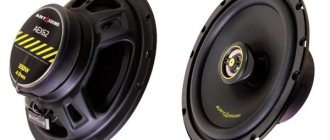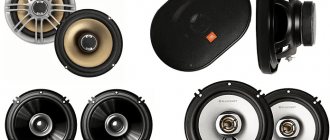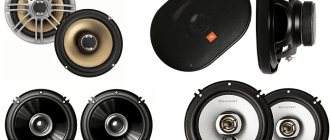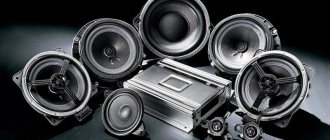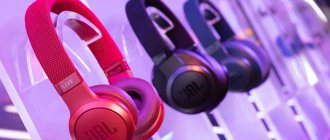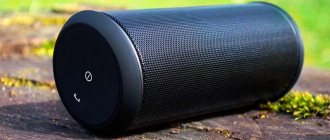September 11, 2020
The idea to write this article came to me after our video on the YouTube channel, then we received a bunch of negative reviews from those people for whom replacing the speakers helped - although we were talking about the likelihood of negative consequences, which, unfortunately, is not uncommon in our installation practice.
Let's agree right away
- Firstly, we do not take into account rich configurations with expensive sound, which, by the way, are not worth the money at all - we will talk about them in the next article. Let's take standard solutions that automakers use in 90% of cases.
- Secondly, we are not considering replacing standard speakers with stage speakers with mega sensitivity, because the stage has its own characteristics, like far-field speakers. They have a very narrow range and by replacing one with the other, you will achieve volume, but will completely deprive yourself of low frequencies and the picture inside the car may turn out to be very flat, more details here, so only classic speakers with a wide frequency range are taken into account.
So, you buy a car and you are not happy with the sound. The first thing that comes to mind is to change the acoustics. And, it seems, everything is logical, car manufacturers save a lot on speakers and head units, and by changing, for example, the speakers, you can already achieve some result. I’ll tell you this, yes and no - 50/50. Although the standard systems are cheap, the source and speakers are quite balanced and selected according to certain characteristics.
How to choose the best car speakers
The choice of speakers directly depends on the musical preferences of the car owner. However, there are a number of criteria to consider before purchasing these devices.
The main parameter is the type of acoustics:
- component.
- coaxial;
- broadband connection;
Wideband acoustics consists of a loudspeaker. Plays music at all frequencies (low, mid, high). This option is suitable for listening to the radio or soft music. These types of speakers are the most affordable, which is why car manufacturers build them into their cars. It is recommended to buy such a speaker only if the car does not have speakers. Changing it in the frame, as a rule, does not make sense.
The next type is coaxial acoustics. This column type is considered extended. Instead of one speaker, several are placed simultaneously inside the case. A separate speaker reproduces a separate frequency range. This makes the reproduced sound more spacious and improves its clarity.
Component speakers, like coaxial speakers, have the same set of drivers. But they are located in separate buildings. For this reason, the sound is rich and detailed. Today, component speakers are the most advanced, but they have a corresponding price.
Having decided on the type of acoustics, they move on to the remaining criteria:
- Rated and peak power. Nominal: The power at which the speaker operates for a long time without distorting the sound. Peak power refers to the peak level of sound emitted by a speaker. However, such a column does not work for long.
- Number of stripes. “Full width” refers to the bandwidth and number of speakers used in acoustics to separate sounds into frequencies. If we ignore the theory, the principle of choice is simple: the more bands, the clearer and more detailed the sound of the speakers.
- Frequency range. This setting determines what frequencies the speakers reproduce. In simple models, the frequency range is from 50 to 20,000 Hz. If sound quality comes first for a car owner, then the range should be at least 30-35,000 Hz. The wider the range, the better the acoustics at its edges.
We destroy the myths about the “variety” and make the speakers play
Acoustics test for a loud front - two full-range speakers and four horn tweeters
There are a lot of reviews on “pop” acoustics on the Internet, mostly a simple “I installed it, I liked it / I didn’t like it.” It seems like the idea is honest, everything is clear, but... not always objective. The problem is that manufacturers do not always provide parameters for their speakers. And without knowing them, it’s easy to make a mistake, and a successful model will remain misunderstood and unclaimed. Now I will try to show that not all broadband devices can be installed equally. To do this, as always, I use the “heavy artillery” – instrumental measurements. And then the tweeters will get it at the same time. In short, everything is serious.
For the test, I took all the equipment from the same brand, but with different designs. Here, after all, the task was not to compare which brand is cooler, but to understand why each speaker requires its own approach, how to get the most out of the “stage”, why the systems sometimes turn out to be so shrill and noisy, and how not to get ear cancer and a hearing aid by the age of 40. Edge turned up. I took two sets of broadband speakers and four sets of whistles. So, let's go have a look.
Broadband
Edge ED PRO8M-E4 (8 inches)
Since I’m holding it in my hands, a few words about the design. The basket is stamped, so you need to place it carefully. If you overtighten it, there will be a distortion with all the ensuing consequences. The set includes a stylish decorative ring, but you can purchase an optional grille.
Frequency response Edge ED PRO8M-E4
: red curve - along the axis of the speaker, blue curve - at an angle of 45 degrees
- Fs (natural resonant frequency) – 94 Hz
- Vas (equivalent volume) – 8.5 l
- Qms (mechanical quality factor) – 5.69
- Qes (electrical quality factor) – 0.72
- Qts (resulting quality factor) – 0.64
- Mms (effective mass of the moving system) – 24.2 g
- BL (electromechanical coupling coefficient) – 8.1 T m
- dBspl (sensitivity, 1m, 1W) – 92.0 dB
So far there are no surprises, the speaker is designed for installation in a door and likes it when the back side is free.
On the plus side, the resonance is relatively low for a “pop singer,” so you can even try making two settings. The first is for working at high volume. If you want the speaker to not become wheezing, the section with the subwoofer should not be lower than 160-200 Hz. The second setting is for working at low volume. The speaker allows you to lower the sub section to a more reasonable 60-100 Hz. But you shouldn’t pile on with this setting.
The downside is that the moving system is heavy for a stage. As the frequency increases, problems begin earlier than usual - the frequency response above 3 kHz becomes too aggressive. Although at an angle to the speaker axis, the sound does not change very radically, and this is a plus.
Edge ED PRO65G-E4 (6.5 inches)
For the design - a solid five. The basket is cast, durable, the speaker comes with a protective grill already glued in. Let's look at what's going on in terms of sound engineering:
Frequency response Edge ED PRO65G-E4
: red curve - along the axis of the speaker, blue curve - at an angle of 45 degrees
- Fs (natural resonant frequency) – 107 Hz
- Vas (equivalent volume) – 6.1 l
- Qms (mechanical quality factor) – 5.73
- Qes (electrical quality factor) – 0.46
- Qts (resulting quality factor) – 0.42
- Mms (effective mass of the moving system) – 7.6 g
- BL (electromechanical coupling coefficient) – 6.3 T m
- dBspl (sensitivity, 1m, 1W) – 94.2 dB
Very easy movement, the speaker works much lighter and smoother at high frequencies. Has higher sensitivity, which means you'll get high volume with fewer speakers.
And now exactly what I was talking about at the very beginning. With a normal installation in the door, there will be an early decline in the frequency response, and you will get the most ordinary mid-frequency driver, and even one that is not overloaded at the highest volume. And here it seems like he can be put aside without understanding how he can play...
But it’s not in vain that we started measuring here, right? If you look at the results more closely, it turns out that this speaker will reveal its capabilities not in the door, but in... a bass reflex housing. Moreover, you don’t even have to fence complex structures. The most compact option is only 4 liters per speaker with a 105 Hz port. For two speakers you will need only 8 liters of clean water and a round 8-centimeter port with a length of 10 cm. And then it will no longer be an overloaded “orun”, but a full-fledged worker on the loud front. For it, as for the 8-inch ED PRO8M-E4, it will already be possible to make two settings - for high volume and for low volume.
That's it, friends, this is enough for now with broadband. I hope it was possible to clearly show that each speaker requires its own conditions for normal operation. Conclusions will be at the end, but for now I’ll move on to the tweeters.
Tweeters
All today's test subjects are built the same way - a metal radiating diaphragm is loaded with a horn. A real resonant design, due to which such high sensitivity is obtained. But at the same time, the designs are still different, so you can expect that the results will vary greatly. In short, let's see.
Yes, something important. All speakers were connected via the supplied capacitor. Essentially a first order filter. In all cases, the capacitance of this capacitor is 2.2 μF. On forums there are often signs showing which capacitor capacity corresponds to which cutoff frequency. According to them, for an 8-ohm speaker the cutoff should be around 9 kHz, for a 4-ohm speaker it should be even higher. But this is in theory, which does not take into account too much. I won’t say anything for now, but I’ll just show you how things really are, you’ll understand for yourself.
Edge ED PRO35T-E4
Frequency response Edge ED PRO35T-E4
: red curve - along the axis of the speaker, blue curve - at an angle of 45 degrees
This speaker is nominally 8 ohm. Let's look carefully at the frequency response. The speaker begins to work effectively not from 9 kHz, but almost from 2 kHz! When we turn it on in parallel with a broadband speaker, it turns out that a wide frequency range will be reproduced simultaneously by both speakers! Here is one of the reasons for the loudness of many “variety” systems. In addition, the tweeter’s own resonance ends up in its working area, and here is the second reason for the “dirt” in the sound at high volumes.
To avoid all this, you can replace the capacitor with any other one with a lower capacity. It’s even better to think about a circuit with channel-by-channel amplification, so that you can adjust the crossover frequency between the broadband driver and the tweeter. Fortunately, nowadays even not the most expensive head units can do this. Take, for example, the same Alpine CDE-193BT. Or Kenwood should release something interesting at a reasonable price this year.
Edge ED PRO37TA-E4
Frequency response Edge ED PRO37TA-E4
: red curve - along the axis of the speaker, blue curve - at an angle of 45 degrees
4 ohm tweeter with shorter horn. The frequency response here is more interesting than that of the first speaker, there are fewer irregularities. Although it starts to work effectively, it’s also never at a high level – already from 3 kHz it screams at the top of its voice.
Edge ED PRO38TA-E4
Frequency response Edge ED PRO38TA-E4
: red curve - along the axis of the speaker, blue curve - at an angle of 45 degrees
Another 4 ohm tweeter. The horn here is also short, but narrower. Otherwise the design is similar to ED PRO37TA-E4. The efficiency is slightly higher in the “ringing” region above 4 kHz, but the frequency rolloff begins earlier.
Edge ED PRO4TX-E4
Frequency response Edge ED PRO4TX-E4
: red curve - along the axis of the speaker, blue curve - at an angle of 45 degrees
The largest tweeter in the review with a hefty voice coil. The resistance is 8 ohms, and the same 2.2 µF capacitor is included. What 9 kHz cutoff are you talking about? Look at the photographed frequency response, the tweeter begins to emit effectively at 1.5 kHz! True, all this comes at the cost of hellish unevenness both on the axis and at an angle.
In general, the potential is high, but to get the full benefit of its capabilities, this “whistle” needs to be used only in a single channel and connected to a broadband device, again, no lower than 5 kHz.
conclusions
Well, it's time to summarize. The points.
- “Variety” speakers are only for use in open spaces. Don't expect wideband speakers to work as full-fledged midbass speakers and pump out bass punch. Yes, with a stretch, they can be used as midbass, but only if certain conditions are met - a low volume level and, most importantly, the correct acoustic design. Again. Correct. Acoustic. Decor. Each speaker has its own.
- Be sure to look at the options to select the correct installation option. Not all speakers work for door volume; some require housings. You cannot compare fundamentally different speakers under the same conditions. The ambush is that most “variety” models simply do not have factory parameters. If you press too hard, then contact us - it’s better to measure once than to cut the wrong thing seven times.
- Tweeters actually play lower than you would expect when selecting a capacitor simply from reference tables. There is no need to blindly navigate only by them. Experiment with the nominal value. Don't be afraid to reduce the capacitance of the capacitor, this will raise the cutoff frequency and make the sound cleaner.
- Better yet, build a loud front immediately according to the scheme with channel-by-channel amplification. By setting the crossover frequency between the tweeter and the broadband, you can achieve really loud sound without loudness and dirt. In such schemes, be sure to limit the broadband frequencies from above. If this is not done, then the broadband driver and tweeter will reproduce too wide a frequency range together, and this is one of the reasons for the sharp, shrill sound.
In general, use the potential of the speakers correctly, and then your system will be called really loud, not screaming.
Rating of 16 cm speakers for cars
The rating of the best 16 cm speakers for a car is based on technical characteristics and reviews from motorists about specific models. Car acoustics are divided into several categories, since the parameters of a coaxial system differ from wideband and component acoustics. To understand which 16cm speakers are best suited for your car, you need to know their basic technical characteristics. These include the following data:
- Resonance frequency
- Peak power
- Rated power
- Moving coil impedance
- Playable frequency band
When purchasing speakers from unknown manufacturers, you need to know that the technical specifications may be significantly inflated or indicated incorrectly, so you should always read reviews from motorists.
Often, when purchasing expensive high-quality drivers, car enthusiasts complain that they cannot get high-quality sound. This usually occurs due to improper installation and installation of acoustics, lack of noise reduction and excessive power supplied to the driver.
Connection features
When connecting a component-type speaker system, the speakers emitting sound are positioned according to your taste, but most often the low-frequency ones are at the rear, since the trunk is a good element for repelling sound waves. Mid-frequency and high-frequency heads are most often located in the doors or dashboard.
The entire connection and its features are associated with a frequency filter (crossover). Depending on the number of system components, it has a paired number of marked pins, which are connected in accordance with the instructions or marked inscriptions. The input is connected directly to the output of the radio, and the other pairs of terminals are connected to the corresponding frequency components. It is not advisable to confuse them, as this may damage the filter element.
After proper connection and installation, the person setting up the speaker system has the opportunity to configure it in many ways. However, for more thorough and fine adjustment of frequency characteristics, you will need an external processor, which increases the cost of the speaker system, but a true lover of high-quality music will appreciate the final result. The digital device allows you to process the sound of your favorite compositions, lowering or raising the desired frequency. Therefore, among the disadvantages of the acoustic component, two factors stand out - the complexity of installation and cost, but they are fully compensated by the pleasure of listening to high-quality, rich music.
Best 16cm Component Speakers
Component acoustics consists of several speakers and a passive filter to separate the audio frequency range. Most often, good 16cm speakers in a car without an amplifier consist of a full-range driver with limited treble and a tweeter. The locations for the emitters in the car are chosen so that the sound image is as clear and high-quality as possible. The top 16 cm speakers and car speakers are driven by Japanese Pioneer TS-170Ci speakers. The system perfectly reproduces the entire audio range, but for best sound quality it must be connected to an amplifier.
The system is perfectly installed on standard seats of various cars. Thanks to their reduced thickness, not exceeding 5.9 cm, the speakers can be easily installed in the front doors without installing an additional podium. The evaluation of 16 cm speakers in a car continues with the JBLCS760C acoustics. The main driver produces pronounced low frequencies that harmonize well with the central band of the audio range. The crossover assigns bandwidth to Twitter, which renders them clearly and without distortion. The system can withstand power overloads without creating audible distortion. Typically these speakers are installed in the front doors of the cabin.
They are installed without modification. Inexpensive 16 cm speakers with good sound include the NAKAMICHINCE - CS 1617 system. This high-quality acoustics provides clear sound with good low frequencies and light glassy highs. Please note that connecting the speakers directly to a stereo system without an amplifier does not provide deep bass, but reproduces the center of the sound range well. Acoustics are afraid of overloads, so it is not recommended to use them at critical power levels. The best 16cm component speakers are often used by car enthusiasts to replace their regular speakers.
Types of component acoustics
The variety of these systems comes down to the presence of several speakers, which are its main elements. Therefore, the component system is divided into:
- Two-component, consisting, for example, of a low-frequency and high-frequency speaker. The main rule is the number of components emitting sound waves. Therefore, it could be a low-frequency tweeter, plus a high-frequency tweeter, or any other configuration;
- Three-component, similarly consisting of three sound wave emitters with different operating frequency ranges;
- Four-component and five are used extremely rarely.
Alpine SPG-17CS
Alpine SPG-17CS is a good audio system without an amplifier, but at a nice price.
Features powerful speaker characteristics.
The tweeter has a silk dome and the magnetic drive is made of neodymium. The design is equipped with ventilation ducts for proper distribution of air flows. Overall, the system has smooth, high-quality sound.
Characteristics:
- size – 16 cm;
- stripes – 2;
- power – 70 W (nominal) and 280 W (maximum);
- frequency – 68 – 20000 Hz.
- included - external crossover;
- tweeter material - silk.
Pros:
- transparent sound;
- high-quality assembly;
- reasonable price;
- Possibility of installing a tweeter of your choice.
Minuses:
- low frequencies play well when tuning;
- Great possibilities of equipment only with door installation;
- without an amplifier they do not produce high-quality bass.
The average cost is 6200 rubles.
Prices for Alpine SPG-17CS:
[dynamic_widget id=ratings2 tag=.tovar2]
Audison Prima APK 165
This component acoustics rightfully takes first place in the segment of economical models with amazing sound reproduction performance. The Audison Prima APK 165 car speaker includes: a 16-centimeter speaker, additional acoustics of 6.5 centimeters, and a crossover.
The benefits include ease of installation, advanced design and a traditional approach to Audison's unique sound.
The kit includes all the necessary accessories for varying the installation of speakers in the car, and the miniature crossover does not require special attention. There is a three-wave suspension that is designed to reduce unstable resonances - it also improves frequencies at each volume level. The speaker is presented in a soft silk dome with special impregnation.
Technical indicators:
- size – 16.5 cm;
- stripes – 2;
- rated power – 100 W;
- maximum power – 300 W;
- frequency – 60 – 20000 Hz.
- crossover included;
- tweeter material – silk with protective impregnation.
Pros:
- great sound;
- increased calibration sensitivity;
- bright transmission of timbres;
- high volume.
Minuses:
- simple design;
- high frequencies need to be corrected.
The average cost is 12,100 rubles.
Prices for Audison Prima APK 165:
[dynamic_widget id=ratings2 tag=.tovar4]
Ground Zero GZTC 165TX
The Ground Zero GZTC 165TX acoustics are suitable for motorists who love loud and clear sound.
The top rating is based not only on technical characteristics, but also on German build quality.
The sound of the speakers is particularly bright.
Basic indicators:
- size – 16 cm;
- rated power – 110 W;
- maximum power – 160 W;
- frequency – 50 – 20000 Hz.
- The kit includes an external crossover;
- HF speaker magnet – neodymium, silk diffuser;
- woofer magnet – nerrite, paper diffuser.
Pros:
- nice design;
- detailed, soft frequencies;
- good sound effects.
Minuses:
- plastic case;
- The speakers are difficult to dismantle.
The average cost is 6,300 rubles.
Prices for Ground Zero GZTC 165TX:
[dynamic_widget id=ratings2 tag=.tovar5]
Focal P 165 VT 20
Finally - the most “delicious”, like the cherry on the cake, or rather the most “sounding”. The design of the P 165 VT 20 is the result of collaboration between Focal and the domestic brand Chernov Audio. All her performances are at a high level.
The acoustic diffusers are equipped with a special dust-repellent coating and a profile that improves mid-range frequencies even when the radiation is deflected.
The speakers are tonally balanced, and this gives an open and clear range of sound for the mid-range speakers, and a high extension of the high frequencies.
Specifications:
- size – 16 cm;
- stripes – 2;
- rated power – 70 W;
- maximum power – 140 W;
- sensitivity – 93 dB;
- frequency range – 60 – 28000 Hz;
- the tweeter has a neodymium magnet;
- Aluminum woofer.
Pros:
- beautiful effects at every volume;
- good sensitivity;
- high quality sound.
Minuses:
- plastic speaker housing;
- high price.
The average price is 17,800 rubles.
Prices for Focal P 165 VT 20:
[dynamic_widget id=ratings2 tag=.tovar10]
Main selection criteria
When choosing and purchasing component acoustics, you should focus your attention on the following parameters:
- Dimensions suitable for the installation space;
- Power. You cannot install acoustics whose power is less than the final amplifier of the radio;
- Active resistance, there are two options: 4 or 8 Ohms, this indicator must be consistent with the equipment reproducing sound;
- Operating frequency range and number of components.
The price of a particular kit depends on several factors:
- brand awareness;
- technical characteristics;
- quality of materials and components;
- acoustics class;
In addition to the listed criteria, each acoustics manufacturer has individual sound characteristics, which also need to be taken into account in accordance with the preferences of a particular music lover who is selecting equipment.
